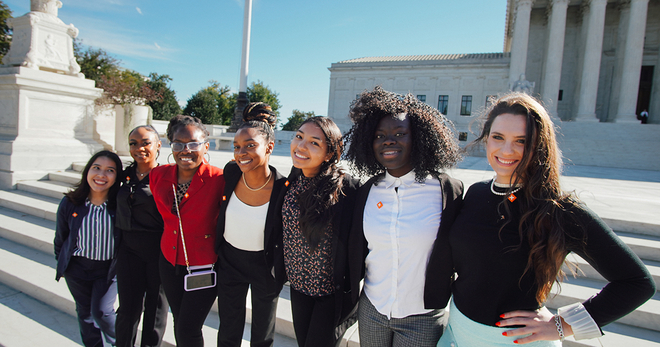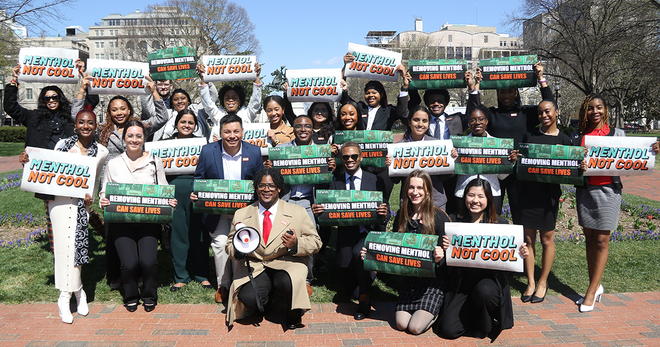Fast Company recognitions underline why youth tobacco prevention is more important than ever
Recent recognitions from Fast Company – Truth Initiative is on its annual list of the World’s 50 Most Innovative Companies for 2020, one of the year’s Top 10 Most Innovative Not-for-Profit Organizations and a finalist for a World Changing Ideas Award for our first-of-its-kind text message program to help young people quit vaping, This is Quitting -- underscore the need for urgent action to confront youth tobacco use.
Driven by the youth e-cigarette epidemic, overall youth tobacco use is at its highest rate in nearly 20 years and the coronavirus pandemic has intensified the need to protect respiratory health.
In the Fast Company story about Truth Initiative for the World’s 50 Most Innovative Companies, the magazine wrote that we “spent decades effectively skewering the tobacco industry” with our truth campaign, have “smartly responded” to the youth vaping epidemic, and are now “ahead of the curve of what became a national conversation about e-cigs.” Fast Company highlighted our free and anonymous program This is Quitting, which launched in 2019 and has enrolled more than 155,000 young e-cigarette users. Teens and young adults can access the program by texting DitchJUUL to 88-709 and get immediate help.
By texting DITCHVAPE to 88709, you consent to recurring messages from Truth Initiative to help you quit vaping, and agree to the Terms & Conditions and Privacy Policy. Text STOP to opt-out. Text HELP for info. Msg & Data Rates May Apply.

We are proud of these recognitions and we also know that our true measure of success is the number of lives saved. Here are 11 reasons why our work to make tobacco use a thing of the past is more important now than ever before.
1. Overall youth tobacco use is at the highest rates in nearly 20 years
Youth are using tobacco at rates unseen in almost two decades due to the epidemic increase in e-cigarette use. New data from the 2019 National Youth Tobacco Survey (NYTS) show that 31.2% of high school students and 12.5% of middle school students — a total of 6.2 million young people — are using some type of tobacco product. This is the highest rate among high school students in 19 years.
2. Flavored e-cigarettes are driving a youth vaping epidemic and a new regulation is leaving many flavored products on the market
Almost all — 97% — of youth who vape use flavored products. The new federal policy on flavored e-cigarettes, which went into effect in February, only limits flavors for specific e-cigarette devices and completely excludes menthol, a popular flavor with young people. Among the other big loopholes: the flavor restrictions do not apply to open-system, refillable devices or disposables like Puff Bars, which may become an increasingly popular e-cigarette because of its variety of flavors like O.M.G. (orange, mango, guava) and sour apple.
3. E-cigarette executives admitted under oath that even they don’t know all the harmful effects of nicotine
Chief executives admitted, under oath, that their products can lead to nicotine addiction and that they do not know all of the harmful health effects of nicotine at a Congressional hearing in February 2020, where they also failed to take responsibility for the role they’ve played in the youth e-cigarette epidemic.
4. Big Tobacco is waging a massive campaign to rebrand itself as do-gooders, while also protecting its bottom line
Big Tobacco is trying to recast itself as part of the “public health solution” to end smoking while it continues to spend billions each year to market and sell cigarettes. At the same time, it is aggressively growing its market base among youth and young adults, putting a new generation at risk for nicotine addiction with an expanding product portfolio of electronic, non-combustible tobacco products like e-cigarettes and heated tobacco devices.
5. Many young people want to quit vaping but need resources to help
A Truth Initiative survey shows that almost half of 15- to 24-year-olds who vape say quitting e-cigarettes is a 2020 resolution and results of the 2019 NYTS also indicate widespread interest in quitting. More than half — 54.5% — of middle and high school students who currently use e-cigarettes reported seriously thinking about quitting and nearly as many — 52.9% — reported trying to quit in the past year, according to the national survey by the Centers for Disease Control and Prevention. These data underscore the urgent need for tools to help young people stop vaping, such as This is Quitting.
6. Menthol cigarettes, flavored little cigars and other flavored tobacco products are still on the market and attracting young people
Federal law bans flavors in cigarettes — excluding menthol — but not in other tobacco products, such as smokeless tobacco, cigars and hookah. That means flavored tobacco products come in many forms, including menthol cigarettes, which are easier to smoke, harder to quit and more likely to addict youth. They also include smokeless tobacco, cigars, hookah and e-cigarettes that come in candy-, fruit- and cocktail-flavored products like sour apple, cherry, grape, chocolate, strawberry margarita, appletini, piña colada, cotton candy and cinnamon roll, to name just a few.
7. Some populations and areas of the country still smoke at much higher rates
The decline in the overall U.S. smoking rate disguises a persistent problem. Some communities have not experienced the same reduction in tobacco use as others, and certain areas of the country continue to use tobacco at disproportionately higher rates compared with the rest of the country. Tobacco use also disproportionately affects many other populations — including people in low-income communities, racial and ethnic minorities, LGBTQ individuals, women, youth, members of the military and those with mental health conditions — who have a long and documented history of being targeted by the tobacco industry.
8. Tobacco imagery is pervasive and rising in popular entertainment and culture
Despite a 1998 federal law prohibiting paid tobacco product placements in movies and TV programming, tobacco imagery can still be seen on screens everywhere today — including movies, TV, streaming media and video games. Tobacco imagery across these platforms contributes to the renormalization of smoking, risking the national progress that’s been made to reduce the smoking rate. Additionally, the expansion of the media landscape means that there are more opportunities for exposure than ever before. For example, the popularity of streaming, combined with the pervasive rise of smoking in episodic content, is putting a new generation of young Americans at risk.
9. E-cigarettes are compounding the serious problem of tobacco litter and the environmental impact of tobacco products
Many e-cigarette pods and cartridges and disposable e-cigarettes are single-use plastic items, which create substantial waste. When they are littered, they compound the issue of tobacco product litter. Since the 1980s, cigarette butts have consistently comprised 30-40% of all items collected in annual international coastal and urban cleanups. E-cigarettes can also leak heavy metals and residual nicotine into the environment.
10. Tobacco is still sold in pharmacies
Pharmacies are a top destination for health care, yet most major pharmacy chains sell tobacco — a product that kills 1,300 people every day and remains the leading cause of preventable death and disease in the U.S.
11. Tobacco use is still the leading cause of preventable death and disease in the country
In the U.S. alone, there are more than 540,000 tobacco-related deaths per year. While most smokers say they want to quit, annual quit success rates remain low – at roughly 7 percent – underlining the highly addictive nature of nicotine.
For more information, see our articles and resources on prevention, the youth vaping epidemic and quitting.
More in tobacco prevention efforts
Want support quitting? Join EX Program
By clicking JOIN, you agree to the Terms, Text Message Terms and Privacy Policy.
Msg&Data rates may apply; msgs are automated.



